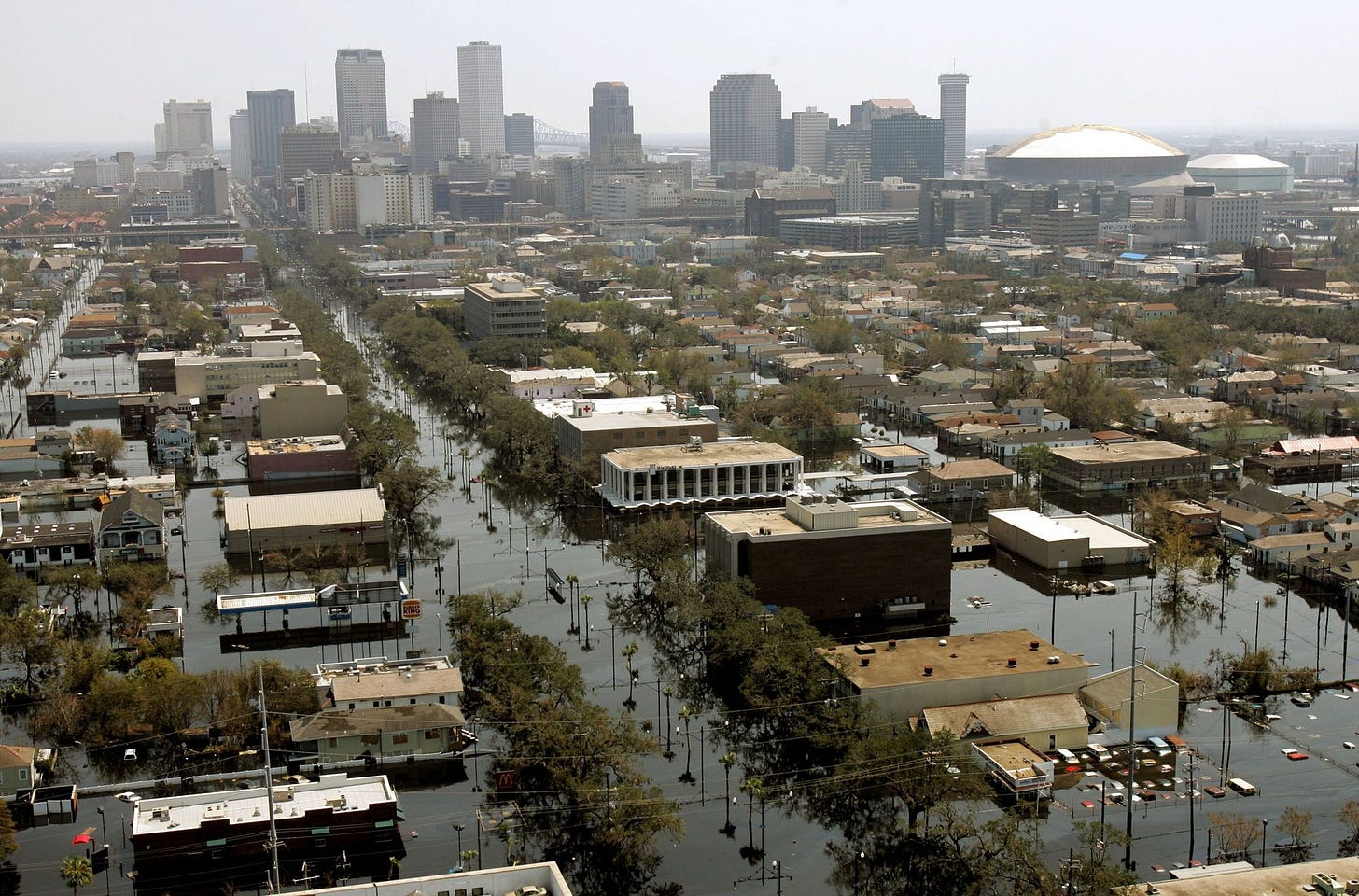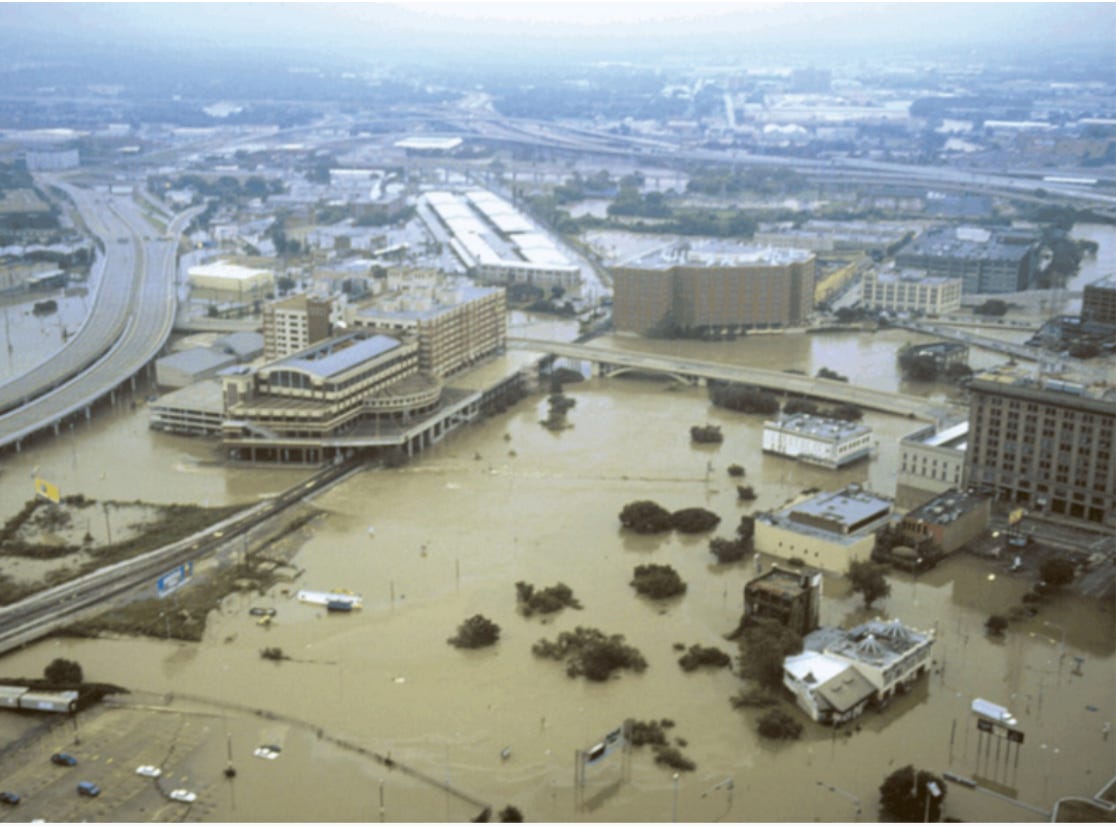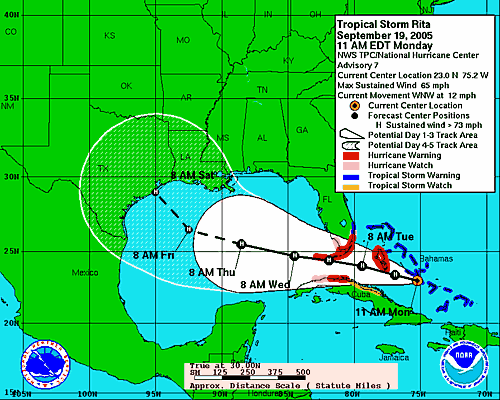Run From The Water?
Hell, run from all of it.
The dog days of summer aren’t a friendly time to be on the Gulf Coast. Historically, it’s seen the likes of the 1900 Galveston hurricane, Alicia (1983), Camille (1969), Ike (2008), Betsy (1963), and — of course — Katrina and Harvey.
It’s a week of joyless anniversaries around here. For starters, today marks 20 years since Katrina barreled into SE Louisiana, causing devastating wind and surge damage on the Mississippi coast and leading to the collapse of several levies in New Orleans, devastating the lower-lying (read: poorer) sections of the city. That NWS warning from August 28 is still one of the most harrowing things I’ve ever read that wasn’t written by Cormac McCarthy.
This recap is from Harris Country meteorologist Jeff Lindner:
The large size of the hurricane and tropical storm force wind fields drove a historic storm surge into the southeast Louisiana, Mississippi, and Alabama coasts. A storm surge of 10-28 feet occurred along the US Gulf coast in Louisiana, Mississippi, and Alabama including a record 27.8 ft at Bay St. Louis and Pass Christian, MS and 28.0 ft at the Hancock County EOC in MS surpassing the previous record from Hurricane Camille (1969) of 24ft near Bay St. Louis, MS.
The storm surge breached and overtopped several sections of the levee and floodwall systems protecting portions of southeast Louisiana including metro New Orleans with a total of over 50 failures in the protection system which ultimately resulted in the flooding of around 80% of the New Orleans metro area. It took 43 days to de-water the City of New Orleans.
It’s also a mere eight years since Harvey parked its ass over Texas and brought up to 60” of rain (in Nederland, near Beaumont) over a four-day period. Houston, a city that never met a half-baked housing development plan it didn’t like, flooded catastrophically.
The saying we always hear in these parts is, “Run from water, hide from wind.” The majority of deaths from tropical systems are a result of storm surge or flooding, so it’s pretty sage advice. We live on what counts as “high ground” in Houston (75 feet above sea level), so we’ve ever flooded. Well, not from high water. Getting a few walls sheared off our house was another matter.

With apologies to T.S. Garp.
Hurricane Ike was a Cat 3 when it made landfall on September 13, 2008. Most of the damage inland, as you can see, was from winds in the eyewall, which passed directly over Houston. Ours was the only tree that came down on our street (woo hoo!), and — though I don’t have any pictures of it — the trunk look like it had undergone a spiral fracture. In short, we think a tornado dropped low enough to twist the tree out of the ground and drop it on our house.
We (me, my wife, and our oldest) were in Florida at the time. That was a planned trip to visit my wiling grandmother, who passed while I was in the air on the way to Ft. Myers (real banner weekend for our family). Had we not, it’s entirely possible we would’ve stayed to ride it out. That tree fell on our daughter’s bedroom, so I’d prefer not to think about that timeline.
The early ‘00s were the first time I really started paying close attention to tropical forecasts. In September, 1998, TS Frances hit us and dumped about a foot of rain on Houston. The water got up to the top step on our porch before receding, but it was a rental, so whatever. Our upstairs neighbor Scott and I spent most of that morning helping people push their cars off the street, which was mostly pointless, as by the time the majority of those stoners woke up, the water was already into their cars (it was about thigh high on the street).
[One girl in particular stands out, however. Not because she had one of them newfangled (at the time) VW Bugs, but because of the huge stack of Hustler magazines she had on her back seat. Figures I was already married at the time.]
TS Allison was a different matter, because we’d just bought our house two weeks earlier. It came onshore, dropped 6" of rain before going north, then turned around and camped over Houston (dropping 16" of rain in my neighborhood in 10 hours). I sat on the porch watching the waters rise until the beer ran out (around 4 AM). As it turns out, the water never got closer than 15 feet to the house, and knowing that something like Allison wouldn’t flood us was a pretty nice housewarming present.
But Ike changed our mindset, and we haven’t stuck around for most subsequent storms. Surge isn’t an issue this far inland, but there are still a shitload of tall pine trees on our street, and I’m not willing to tempt fate, because … well, you’ll see.
We were also part of the (net) mass exodus from Houston in the runup to Hurricane Rita. That storm was, at the time, the most intense hurricane ever recorded in the Gulf of Mexico (it’s now tied with Milton), and as you can see from the NHC graphic below, they had it targeting Houston from the jump.
Like Katrina, Rita jogged right at the last minute, making landfall near Sabine Pass, but we were already well away, and having bugged out the day before several million of our fellow upper Gulf Coast residents, we didn’t experience the traffic nightmare that led to 107 deaths, as people were stuck in gridlock during that late summer heatwave.
Katrina was a major contributing factor in that cluster fuck. Everyone in Houston had seen the footage of New Orleans and heard the (ultimately untrue) accounts of mass looting and crime. Never mind that Houston (eventually) drains without the aid of pumps, Rita was — on its approach — a Category 5 monster aimed right up the chute. It caused plenty of damage to the coasts of SE Texas and SW Louisiana, but a Ship Channel landfall would’ve been apocalyptic.
We got a whole home generator a few years ago, but that was mostly because of the state’s notoriously shitty power grid. In theory, I figure we could ride out anything up to and including a Category 2, but I’m increasingly wary of any approaching systems. We bugged out for Laura in 2020, and were also out of town when Beryl hit last year (planned trip to Gulf Shores), so we missed the fun of our neighbor’s tree coming down in our front yard:
Fun(?) fact: I had to track down the owner of the house next door to inform him two of the massive pines in his front yard were dead and, were they to come down on someone else’s property, he’d be liable for any damage. Crews came out and cut them down two days before landfall. That one above, that missed our house by about three feet, was one of the healthy one.
Power was out in our neighborhood for over a week. Centerpoint, the local electric company, has spent much of the last year assuring us they’re ready for future storms, making infrastructure updates a couple of decades overdue and — naturally — hiking rates to pay for it. Funny, I could swear Governor Abbott said the grid was fixed following the 2021 winter storm.
Cold comfort or not, the fact is that Houston is overdue for another hit from a major hurricane. Ike was a Category 2 (though it pushed a Cat 3 surge), Rita missed, Harvey made landfall 180 miles away, in Rockport, and was only a tropical storm when it stalled over Houston. Hell, Beryl was a Category 1 and still crippled the city for over a week. And if my faith in local infrastructure is lacking, that’s nothing compared to the shitshow in Washington, DC.
Again, from Jeff Lindner:
Surveys conducted at several of the failure locations post storm revealed inadequate building practices of the I-wall floodwall structures allowing overtopping to erode the soft material the flood walls were constructed on and the pressures of the storm surge to topple over sections of the walls. In some instances, the storm surge was great enough to overtop and destroyed the levees which were found in post storm surveys to have sunken below standard design protection levels due to land subsidence.
Land subsidence that was not accounted for in the original Corps of Engineering plans, as it turns out. The Flood Control Act of 1965, passed in the aftermath of Hurricane Betsy, was supposed to complete levies and seawalls to protect the areas around Lake Pontchartrain in 13 years. The work still hadn’t been finished when Katrina hit, 40 years later.
And that was just garden variety late-20th century corruption and incompetence. The same kind that allowed children’s summer camps to be built in the Guadalupe River floodplain without any alert systems to warn them of rising waters.
We’re now living under the yoke of the most corrupt Administration in history, where even governors of red states have to beg for disaster aid and the head of DHS is more interested in getting filler injections for her photo ops than staffing the Federal Emergency Management Agency. As of this writing, there still isn’t an administrator of the Office of National Continuity Programs or FEMA leadership for Region 4 (Alabama, Florida, Georgia, the Carolinas, etc.) or Region 6, which includes Texas and Louisiana.
The ONCP coordinates with federal, state, and local to “continue performance of essential functions and deliver critical services across a broad spectrum of emergencies when normal operations are disrupted.” Seems important!
Enjoy your Labor Day weekend, everybody. The Gulf and Atlantic are quiet, for now, which is about the best our current President can hope for. Because any major hurricane that hits a metropolitan area in the next three years is going to make the federal response to Katrina look like the apex of government efficiency.
Meanwhile, we’ll keep running from wind *and* water. Thanks to climate change, I’ve now seen enough “once in a lifetime” weather events to qualify as Methuselah, and I’d rather camp out in a hotel room with my family than sit in a wrecked house, without power, waiting for help that may never come.






Glad you’re all so proactive about getting away well in time, and also at being such a good neighbour. Thanks for this post, I learned a lot! Have a good Labor Day weekend.